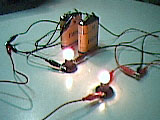


|
Parallel circuit
Science at Home |
||
|
Materials
|
|
Videos: download.avi (281 KB)
Pictures: 
|
|
Procedure
1. Link the two batteries poles (+) and (-). 2. Link one of the string (1) crocodile to the pole (+) of the two batteries. 3. Link the other string (1) crocodile to two crocodiles of the strings (2) and (3). 4. Link the free strings (2) and (3) crocodiles to one of the supports (1) and (2) connections. 5. Place the lamps in the supports. 6. Link the remaining connection of each support to the strings (4) and (5). 7. Link the remaining crocodiles of the strings (4) and (5) to the string (6) crocodile. 8. Link the free crocodile from the string (6) to the poles (-) of the batteries. What has happened? 9. Next, disconnect one lamp from the support. What has happened? 10. Connect the lamp that you have removed and remove the other. How does the system behaves? |
||
|
Why?
In contrast with the serial circuit, if we remove a lamp of the support, the other lamp doesn't fade. As always, the electrons flow from the (+) to the (-) pole. When we remove the lamp of one of the supports, the electrons don't move in that branch of the circuit. However, that doesn't implicate that the circuit is closed because the electrons have an alternative way (other branch). |
||
 |
No part of this website can be reproduced without previous authorization. Please inform me if there is any problem with the website. |